This blog is actively maintained by team members of My Crystal Bridge. The blogs provide insight information on Chinese cloisonne, Chinese culture & history, Chinese arts and crafts. If you like to comment on any contents in this blog, please email the webmaster. Thanks.
![]() Subscribe to blog RSS feed: copy and paste the following URL to your favorite RSS feed reader
"http://www.mycrystalbridge.com/blog-feed.rss"
Subscribe to blog RSS feed: copy and paste the following URL to your favorite RSS feed reader
"http://www.mycrystalbridge.com/blog-feed.rss"

17. A Quick Look at Late Qing Chinese Cloisonnes - March 2011
Chinese cloisonne started to appear in Yuan Dynasty in the 14th century. It sooner became a luxury goods adored by the imperials. It was during the Jingtai reign in Ming dynasty that cloisonne flourished to its first peak in Chinese history. During Ming dynasty, the emperors funded shops in Beijing to serve exclusively to the royal courts and nobles. Since most cloisonnes made during this period were in blue color, Chinese cloisonne was given the name Jingtai Blue.
The Qing emperors, especially KangXi and QianLong, were even more obsessed with these colorful glass-like wares than the Ming rulers. They spent tons of silver on the imperial cloisonne shops to make the most lavish cloisonne ware to be admired by the royal family members and their high court officials. They hired and trained highly skilled artisans to work on cloisonnes day in and day out. The emperors' obsession with cloisonne pushed the technology to its new high and created hundreds of cloisonne experts. At this time, cloisonne was only available to very few people at the top of the social classes.
By late Qing dynasty, between late 19th century and early 20th century, China's economy and political power started to decline. Western countries had invaded several coastal cities and set their presence through political bodies and businesses in major cities, such as Beijing and Shanghai.
Meanwhile, the late Qing emperors could no longer afford funding imperial cloisonne shops. These skilled cloisonne artisans had to move away from the emperor's patronage and find new ways to make a living. They went out and founded their own commercial shops, focusing on making cloisonne products that could sell. There were several famous cloisonne shops during this period, such as Lao Tian Li, De Xing Cheng, Bao Hua Sheng, Jing Yuan Tang and Zhi Yuan Tang. Their products moved away from luxurious decorative items to more functional and practical items. At the beginning, these shops' products were following traditional Chinese art trends and values. But they soon evolved to catering to western styles and flavors. This style of cloisonnes was made mostly for exporting.
At around the beginning of 19th century, business men from western countries had already gained knowledge of Chinese cloisonnes and adored them. They brought in new life for Chinese cloisonne. At first, they would buy from Chinese shops then resold to their own countries. Through these trademen, Chinese cloisonne entered western homes and soon became a hot item. In the early republic (1911s), western businesses started to invest their capital in Chinese cloisonne workshops to obtain better profits.
In 1904, an incense burner made by Lao Tian Li was showcased in Chicago World Expo and won first prize. This event brought the name of Chinese cloisonne to thousands of American households. It triggered a much bigger wave of Chinese cloisonne exporting.You can still find late Qing dynasty cloisonnes in the US today, although the chance is rare and far between. I recently had the opportunity to exam a genuine De Xing Cheng cloisonne vase. This vase bears the marks of late Qing cloisonne all over its design and colors. See below pictures of this lovely vase.

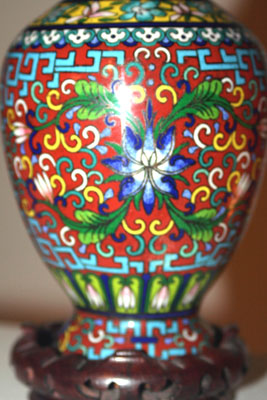
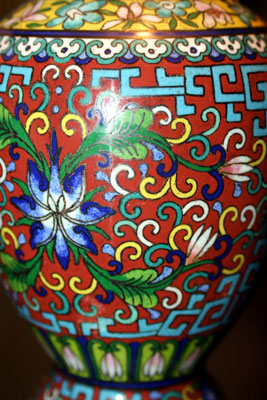
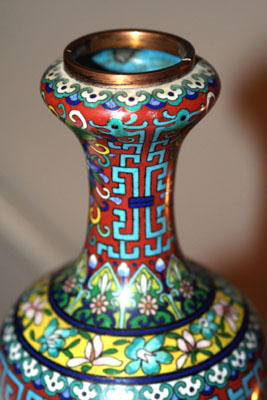


The body of the vase is made of bronze, a typical metal used in Qing dynasty. The enamels are very bright, which is a bit different than traditional Chinese cloisonne. Traditional Chinese cloisonnes usually use moderate colored enamels without creating much contrast. The motifs are mostly Chinese, such as the blue white flower on the body. But the flowers around the neck are not commonly seen in antique Chinese cloisonne. It has more Japanese influence. Japan opened its door to the western world much earlier than China. This vase could well be made for export to Japan.
The mark at the bottom of the vase is made of three Chinese characters, which is the name of the workshop that made it. It reads from right to left "De Xing Cheng". De Xing Cheng made quite some vases in this style. De Xing Cheng cloisonnes all bear similar marks. There are two variations of the middle character, xing, which means flourishing or thriving.
If you'd like to know more about this vase, contact the proud owner Tina Leigh. She runs a healthy food catering business in Oregon.

16. A Glimps of Inidan Enameling - Jan. 2011
On a sunny winter Friday noon, I walked into an Indian restaurant with several colleagues to have lunch. Lunch is served in buffet style. There was this pleasant aroma of roasted chicken mixed with Indian spices. But what stunned me most was not the food but the table tops of these small square wooden tables. They looked so elegant and colorful from distance. The thick glass quietly reflected the warm winter sun into every direction in the room.
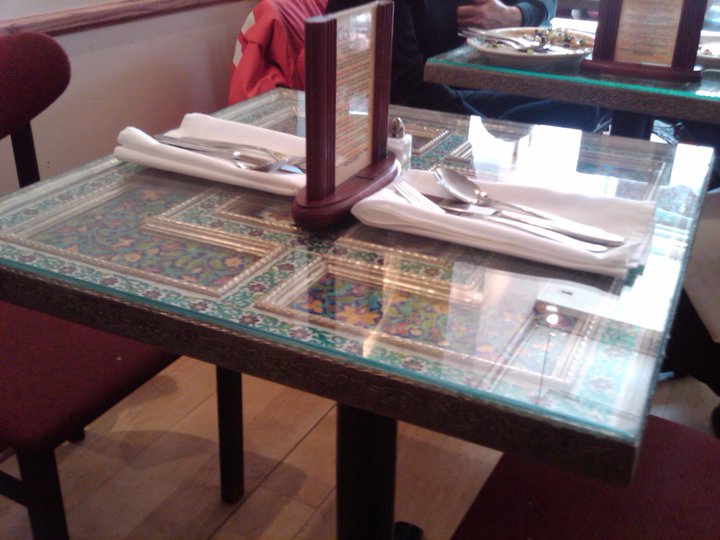
After sitting down by the table, I started to observe these table tops. To my suprise, they were enamels. I knew Indian made enamel wares throughout the history too but not as much as China and Japan. So I haven't read much about them or actually seen any. But at this very moment, I was sitting next to one.
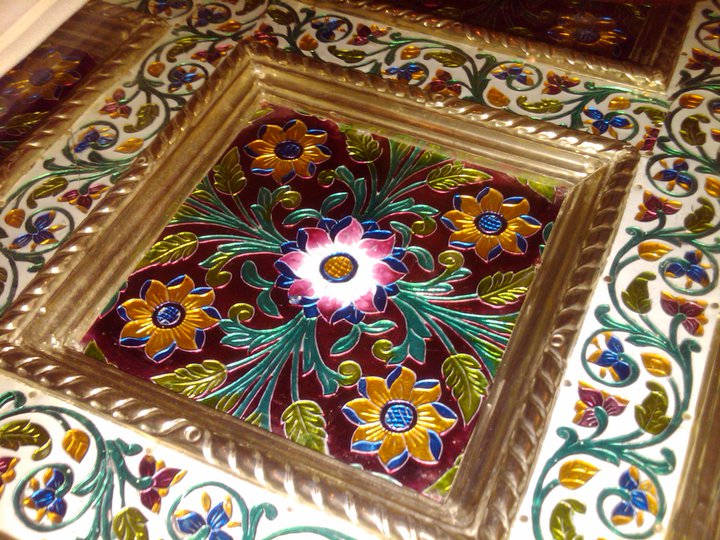

The metal piece was made of aluminum or an alloy of aluminum. It was pressed with delicate symmetric and repetative floral designs. A very typical style you'd find in Islanmic influenced culture. The depressed cells were filled with a thin layer of enamel in all sorts of bright colors. The design was so vivid that you can almost feel the flowers and stems swing with the breeze.
This type of enameling is more like champleve, which is very popular in Europe, instead of cloisonne, which is popular in Asia. Cloisonne would use metal wires soldered onto metal surfaces to form the design. Champleve would use a cast with high presure to press the design.
After my intitial encounter with these Indian enamel table tops, I decided to do some research on Indian enameling. It turns out they are mostly like the table tops - hard pressed design filled with thin layers of colorful enamels. These enamel wares come with all shapes and functionalities. Panels for decoration, bowls, trinket boxes, trunks or chests.
See more pictures of Indian enamel wares below. If you know anything about Indian enamels, please drop me a line. I'd love to learn more about them.
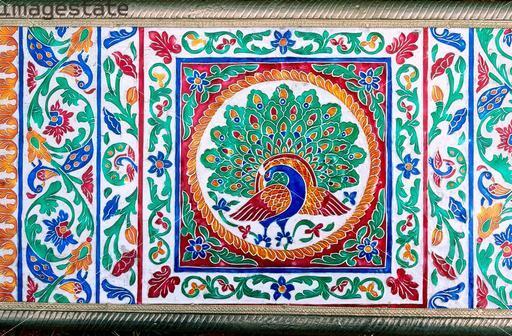
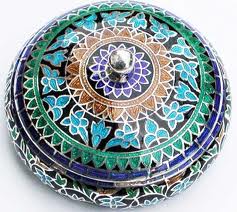
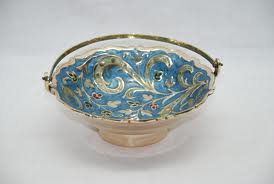

15. The Different Types Of Japanese Cloisonne - Dec. 2010
Japanese cloisonne has a long history dated back to the 18th century. It is one of the most beloved art forms when it comes to collections. There is a huge market for antique and modern cloisonne pieces. For a new collector of Japanese cloiosnnes, it's often confusing of the different types. Although the base material and techniques to produce these different types of cloisonne are similar, there are some subtle differences. When deciding what type of Japanese cloisonne you would like to buy, consider the following types:
Shotai-Shippo is the oddest of all of the Japanese cloisonne. This cloisonne is made with translucent enamels with the standard techniques of the yusen-shippo (wired cloisonne, see below). It is then dipped in a pot of nitric acid. The metal of the body dissolves which leaves only the metal wires and the enamels. The effect is very similar to stained glass. The finished pieces are much lighter than other types of cloisonnes at similar size.
Totai-Shippo are enamels painted on porcelain. The body of the art objects is made of white porcelain. Translucent or opaque enamels are painted onto porcelain with designs similar to those of cloisonnes. The finished work has the same look and feel as cloisonne but there is no metal wires used. Similar pieces can be found in Chinese cloisonne. But the Chinese versions are enamels painted on metal, mostly copper.
Dei-Shippo is used when describing opaque, matte enamels prior to the development of the brighter enamels, which was introduced to Japan by a German chemist. Dei-shippo pieces were made in bulk during the Meiji period and there are still a lot of antique pieces available. The opaque enamels look more like stones than glass.
Ginbari-shippo is very unique in a way that a silver foil is used underneath the enamel. The foil is impressed with small even dips and simple designs such as birds or bamboo leaves. Above the silver foil, standard Yusen-shippo techniques are used for the main design. When viewed from distance, gibbari-shippo has a fish net effect and glitters due to reflections from the silver impressions. It also gives a illusion of three dimentions.
Musen-Shippio is wireless cloisonne. The surface of the objects is made of enamels but there is no wires to separate the different enamels in the design. They are known two ways to make wireless cloisonne. The first technique uses the application of enamel to the body directly, more like making oil paintings. The second one applies the wire while the enamel is being painted but removes the wire prior to firing. The second one is one of the most demanding cloisonne making techniques . The Ando Company is one of the most famous for producing exceptional pieces of wireless cloisonne.
Yusen-shippo is cloisonne with wires. This is the most common form of cloisonne. It's actually originated in China. There are thin metal wires (mostly silver in Japanese cloisonne) that are fixed to the body to define the design and the compartments between the wires are filled with various colors of enamel. When the surface of the enamel rises above the metal wires it's called raised cloisonne or 'Moriage-shippo'.
Japanese cloisonne has a wide history and from these techniques we can see that the art range is extremely diverse. When looking for a cloisonne piece to purchase, you can almost always find something with the type of techniques that you like.

14. Enameling Is Believed to Have Originated in Persia - Nov. 2010
It is believed that enameling originated in Persia, also known as Iran today. Then the very sought-after art form spread to the rest of the world. There seems to be historical proofs in documentations citing this particular art technique in ancient Persian books and in other Asian countries such as China.
The origins of enameling should be extremely interesting to an art lover. It's believed the technique was discovered by accident. When metals were mixed with mineral oxides in a fire (maybe a camp fire), a glass like glaze was formed and fused to the metals.
The heart of this art form is to bond a glass surface to other bodies (usually metallic). The transparent enamel powder which was used had to be mixed with sodium carbonate and silica. Powders with oxidizing properties had to be added to the glazing powder to give it colors. These oxidizing powders normally contained tin oxide.
An enamels artist must have to know how to handle various chemical reactions expertly in addition to having the artistic ability of design. It's like modern day's glass making. It's because of this reason, enameling is often referred to as the art of the laboratory.
Traditional Arabic designs were used depending on the preferences and taste of the artist. Persian enamel designs have more disciplines than enamels from other regions. You can usually find symmetric and repetitive patterns in Persian designs.
In Iran enameling, the most common metals used were copper and silver. The most popular forms of enameled art are jewelry, candle holders, vases, doors and chandeliers. In addition to enameling on metals, a lot of Iranian enameling is painted on porcelains. These art pieces are hand painted with traditional Arabic designs by skilled artisans. The white porcelain provides perfect background to the design, often in various shades of blues.
The most important hub for enameling in Iran is Isfahan. One of the most well-known masters that have produced marvelous pieces is Shokrollah Sanizadeh - whose ancestor was also a renowned painter. His work is so celebrated throughout Iran that one of his crafts was selected into a stamp in year 2008.
The current day Iranian artists are still well-regarded and their pieces are affordable with relatively low prices. Finding enameled pieces that were created from Iran is not that hard if you can find the right supplier. Iran has a vast cultural history and this history can often be seen in the traditional decorations of the enamel pieces.
Enameling might have originated in Persia (Iran) but it has developed to be loved throughout the world. You can find exceptional cloisonne works in China and Japan, where cloisonnes are still made in high quality and quantity today.

13. Enameling in Europe - Oct. 2010
As cloisonne enameling developed in the Mediterranean area in the early centuries, Northern Europeans were developing their own technique of enameling. The technique used in Northern Europe was called champleve enameling. The technique that was developed in Northern Europe created impressions that were cast out from the metal base. These impressions were then coated with enamel. This technique is considered to be the opposite of cloisonne enameling, which fixes metal wires to raise the surface then filled the compartments with enamels.
In champleve enameling the most frequently used base materials were bronze or copper. The reason is that this technique requires a thicker backing material that can be carved into or cast away. Once the pieces were finished they were sometimes gilded with gold.
One of the reasons that champleve enameling was so popular was due to it giving a greater freedom to the artist when it came to design - compared to cloisonne. Figures were one of the most depicted subjects in enameling in Europe. The figures created in cloisonne were often formal and rigid due to the techniques it employed. The enamels of cloisonne were also rumored to lose their color after the firing process.
Champleve enameling was popular in Northern Europe until the twelfth century. There were several important pieces of champleve enameling that were discovered through history. One of the most noteworthy pieces was a Birdlip mirror. It was found in England near Gloucester in 50AD.
Towards the 11th century, champleve enameling on copper started to spread to various European countries. It also continued to be produced on a commercial scale. However, the interest in this technique started to die down in the 14th century.
As with everything, when they started mass producing the champleve pieces there was a sudden decrease in quality and demand faded for the products. By the 14th century, the technique had spread around other European countries and there was a greater variety of design.
Because the enamels for champleve were sparse there were only three main regions which produced the ware. These towns were Rhine, Meuse and Limoges in Spain. The Meuse enamels were extremely high quality and were in big demand in many different regions. The Lorraine enamel was known from a rather early date due to the fact that Abbot Suger asked his artists to create a large cross in the honor of the Abbot's Patron Saint.
These pieces can be bought today as antiques, usually at a quite high price. Modern champleve pieces are still being created by modern-day artists. Regardless of the time when these pieces were made champleve enameled pieces are remarkably attractive and are highly sought after by determined art lovers.

12. Antique snuff bottles in Forbidden City - Sept. 2010
Snuff bottles were used in China after tobacco came to Beijing in the 16th century. A snuff or medicinal bottle is a small bottle, usually carved out of lapis lazuli, jade, agate, crystal or made out of painted glass, used to carry one's personal supply of snuff. In 16th century China, tobacco was believed to have medicinal properties--it was considered to be good for colds, grippes, and disorders of the digestive and nervous system. It was also used to increase sexual potency.
Snuff became a part of Chinese high society, and business deals were often sealed with a pinch of it, much the same way businessmen today will take shots of aquavit to seal a deal. It was offered to guests when they entered your home, and when you met friends on the streets. To offer a pinch of snuff was to accept another person as a friend, to show bonhomie, and to improve feelings of general companionship. It was the hail-fellow-well-met of its era.
Snuff bottles could be very basic, but they also could be stunning to look at. The best glass snuff bottles had a kind of tactile feeling to them, a smoothness--the material almost felt soft and satiny. In addition to snuff bottles made from precious stones, China also produced the famous inside painted snuff bottles --where the artist has carefully inserted a very tiny, delicate brush into the neck of the bottle and painted the inside. This work is painstaking, exacting --it requires a tremendous amount of patience and dedication. Often, the crafters of modern snuff bottles will wear a loupe over their eyes to see their work.
The forbidden city has an excellent collection of Qing snuff bottles that belonged to members of the imperial families. These snuff bottles are of the best quality -- made of precious materials, designed by highly acclaimed artists and carved or painted by the most skilled artisans. Some of these snuff bottles are available to the public in forbidden city's treasure exhibit. Below are pictures taken from this exhibit.
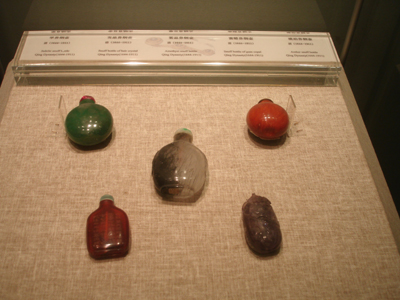 |
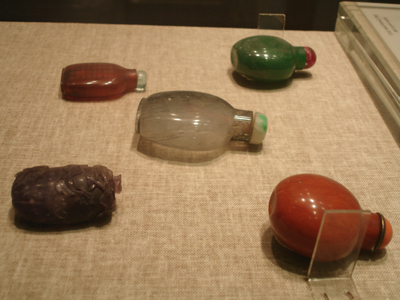 |
In the photos above, the bottles are made of crystal, amethyst, gum copal and amber. Collection of Palace Museum, Beijing, China.
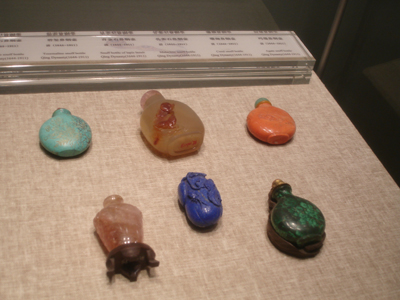 |
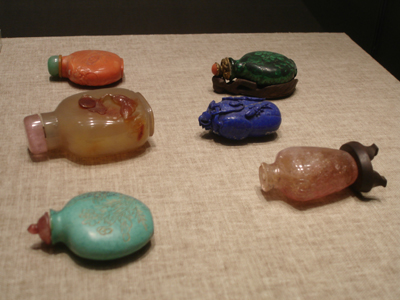 |
In the photos above, the bottles are made of tourmaline, lapiz lazuli, malachite, coral and agate. Collection of Palace Museum, Beijing, China.
The Palace Museum has an excellent website with descriptions of its treasure collections. Click here to read more, Official Palace Museum's snuff bottle collection and other palace paraphernalia.
Below is an antique inside painted snuff bottle from the collection of Beijing Capital Museum. It's not as lavish as those ones belonged to the imperial families but it's more artistic. It was a companion bottle to a Qing dynasty scholar in the 1700s.
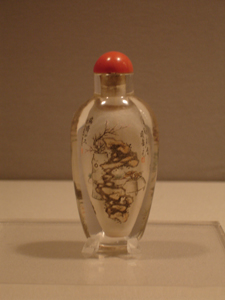

11. An Introduction to Chinese Closionne Enamel - Yuan Dynasty - Sept. 2010
This article includes a series of three sections, which cover the history, artistic and technological characteristics of enamel wares in Yuan (1271-1368), Ming (1368-1644) and Qing (1644-1911) dynasty.
Series 1- Enamel wares in the Yuan (1271-1368) Dynasty, the beginning
In Chinese history, there have been four different types of enamelwares. They are distinguished by the process used to produce them -
The four processes are: cloisonne, painted enamel, champleve and translucent enamel.
Cloisonne is made by gluing copper or brass wires onto a copper or brass body that has been shaped around a frame. Bodies are made in the shapes of vases, trinket boxes, incense burners, and so on.. These wires form small compartments called cloisonne - French for "cells". The cloisonne are then filled with colored enamel powders. The copper or brass wares are then fired several times and polished until the surface is smooth, then gilded with gold.
Painted enamel is made by painting enamel paste directly on copper or brass bodies, much like painting white clay to color porcelain. Then the painted item is fired and gilded with gold.
Champleve is very much like cloisonne except that the cells are not made by wires. The inside of the body of the item is either carved, pressed or stamped to form recesses. The recesses are filled with colored enamel powder. Then they go through the same firing, polishing and gilding process as cloisonne.
Translucent enamel is mostly made in southern China, particularly in the Canton province. It's also referred as "Canton enamel". The biggest difference is the enamels used in this type of artwork. They are translucent instead of opaque. This branch of Chinese cloisonne shares similar characteristics with modern Japanese cloisonne - which almost always uses translucent enamels to give it the look and feel of glass, fine porcelain or polished lacquer.
Modern Chinese cloisonne enamel techniques are thought to have been brought to China from west Arabic regions such as Persia (today's Iran) in the Yuan dynasty. The Yuan dynasty was founded in 1271 by the Mongol King Kublai Khan.
The Mongol army invaded a lot of western central Asian territories during the short reign of its rulers. They killed people mercilessly but kept people with specific skills. They made them slaves and took them back to China. It was believed that skilled enamel artisans were among the people brought in by the Mongolians. This has been recorded in various historical documents in Chinese history.
The Yuan dynasty made their capital in today's Beijing. Persian enamel artisans flourished in Southern China in Yunnan province. They later migrated north to Beijing to find a higher quality of life. They brought their enamel making skills with them. They also brought very high quality enamels to China. These enamels have the look of glass which is different than Ming and Qing enamels.
Yuan's enamel ware design was influenced by Arabic art and culture. You can detect Arabic themed patterns in some Yuan closionnes. But unfortunately, closinnne wares are fragile artifacts and very few from this period survive to this day.
The Palace Museum's collection of cloisonne includes some rare Yuan cloisonne wares. See pictures below:
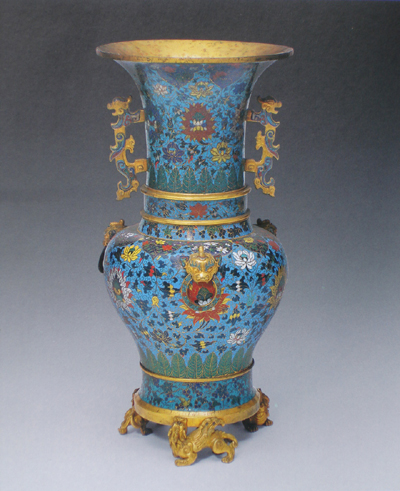
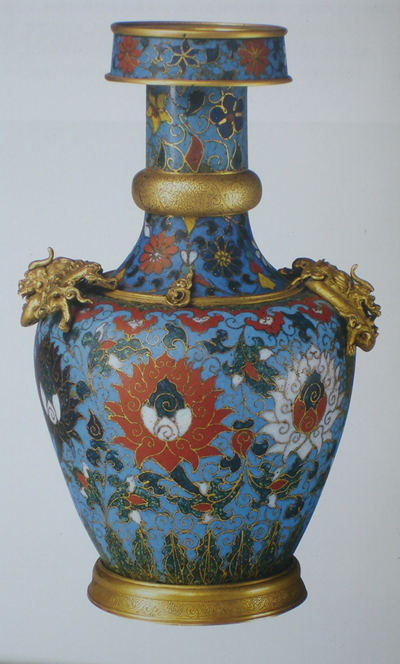


The above pictures from left to right, top to down are
1. Three eared cloisonne wine vessel with lotus flowers and leaves. The enamels are believed to be used only in Yuan dynasty. The vessel was modified in Ming dynasty. The green leaves around
the neck and bottom has Arabic influence to them.
2. Lamaism cloisonne vase. Lamaism is a branch of buddhism, which is the dominate religion in Mongo and Tibet. This vase bears the very shape of a lamaism pagoda. Notice the carvings on the gold
around the neck and bottom rim is very typical Yuan patterns.
3. Three footed cloisonne incense burner. Notice the glassy green and blue colored enamels.
4. Elephant eared cloisonne lotus flowers and leaves incense burner. Notice the glassy green and sky blue colored enamels.
The other way to distinguish Yuan cloisonne is the markings. Usually Ming or Qing wares were marked with Chinese characters to indicate the reign in which the artwork was made. Yuan cloisonnes usually don't usually bear any marks or the sometimes use a design (without any characters) as the mark.
Early Ming wares are sometimes not marked either. So it's a bit hard to the difference between late Yuan and early Ming cloisonnes. This is usually not a big problem since the Yuan dynasty only reigned for 97 years.
Despite its beauty, Yuan cloisonne was not well accepted by the Chinese at that time due to its origin. Yuan Chinese guarded themselves as the center of the world. Persia was considered the "devil country". Anything made by the devil country was not popular and was only suited to satisfy the fancies of women.
Cloisonne techniques kept developing in spite of its early unpopularity. It later became a main interest of the Ming and Qing imperials.
References:
1. Enamel Ware - Collection of the Palace Museum by Chen, Li Hua 2008
2. Oriental Cloisonne and Other Enamels by Arthur and Grace Chu, 1975

10. Authentic Chinese Cinnabar Lacquer - Aug. 2010
Authentic Chinese cinnabar lacquer dates back to almost 2300 years ago in China. While there are many pieces that are originals the first piece of this art form is undocumented and unknown. While many lovers of oriental art know of authentic Chinese cinnabar lacquer most people don't know what it is exactly. This article will take a quick look at the various information around this most prestigious of art forms.
The lacquer known as cinnabar comes from tree sap that is native in China. This tree is appropriately named for the purpose it is used for: Lacquer tree. The lacquer is produced by trunk tapping. The way cinnabar lacquer is created is by adding the pigments into the actual lacquer.
Depending on the thickness of the carving, hundreds of coats used to be needed to get the right amount for the actual object at hand. Usually the bases that are painted on are created out of copper or wood. These types of pieces would usually take months to complete as each coat would have to dry. However, with modern technology, the technique and production of these art pieces has evolved. They are now created much quicker.
Even though the production process has evolved, the integrity and quality of the pieces are still the same. The modern wares are made from lacquer resins and molds. Once the resin has dried out the surface of the wares is hand crafted by a human to give it that unique touch.
You can find authentic Chinese cinnabar lacquer in the form of plates, bracelets, pen holders, trinket baskets and even vases. The stunning deep red color and hand carved designs really bring a touch of class and elegance to any home.
These authentic Chinese cinnabar lacquer items are perfect for an oriental lover who wants to get their hands on pristine oriental art.
Check this 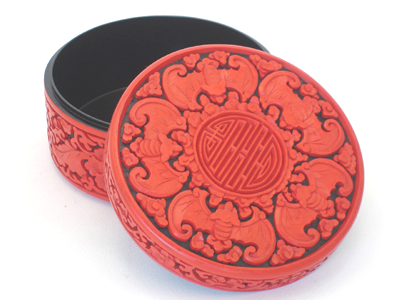
authentic traditionally made cinnabar lacquer trinket box with five bats symbolizing prosperity which we recently sourced from Beijing,
China. There are very few artisans in China who still produce anthentic cinnabar lacquer using the time consuming traditional methods. We are lucky to find them.

9. Is It Really a Chinese Watercolor Painting Used in a Snuff Bottle? - Aug. 2010
When a westerner looks at a Chinese snuff bottle for the first time they are always recorded having two reactions. The first reaction is that they are heavily commercialized and retain none of the historical principles of the ancient snuff bottles. The second reaction is that they can't believe a Chinese watercolor painting was used within the snuff bottle. Both of these are valid points and this article aims to discuss and shine light on these matters.
Depending on the supplier you use for your snuff bottles they are probably hand painted. While a lot of the merchandise in China has been commercialized, it's essential to find a Chinese supplier of products that understands the quality of these matters. My Crystal Bridge is a perfect example of this type of supplier.
The second reaction to discuss is the disbelief that Chinese watercolor painting is used in snuff bottles. The difficult technique is mastered by only a handful of artisans. A bamboo brush is used and inserted through the narrow neck of the bottle. The materials that are used to paint these bottles are glass, chalcedony and rock crystal. When creating a glass snuff bottle an acid solution is used to keep the paint on the glass of the bottle.
Chinese watercolor painting that is used in a snuff bottle is one of the most unique and interesting ways to store British snuff. If you know of a British snuff user that is tired of storing his snuff in those old, commercialized packaging they buy it in, then buy them one of these snuff bottles for them.
This is the perfect present for a British Snuff user who wants to personalize their snuff with an oriental theme. At a bargain of $21 to $35 you will find a snuff bottle for any sized budget.
inside painted snuff bottle beauties with umbraller and swing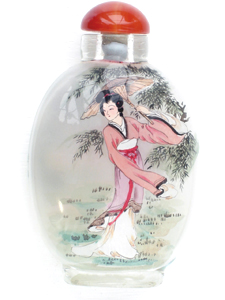
inside painted snuff bottle beautiful lotus blossoms
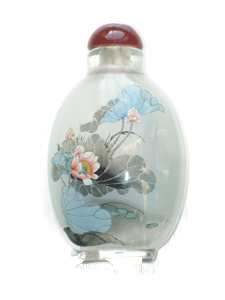

8. British Snuff and an Historic Place to Store it - Aug. 2010
British Snuff is a smokeless tobacco that is scented or flavored and then sniffed through the nose. While the modern variety is available in the flavors of cola, whiskey, bourbon and cherry it is not new. It was introduced in the Q'ing Dynasty to China, which gives it a long and diverse history.
Often used by middle and upper class males in the 19th century, it was a common practice for the men of a household to offer their friends a pinch of snuff. This was a mutual greeting as a fellow and a friend. While many men used boxes to hold their snuff. There are snuff bottles that are incredibly more versatile and visually more appealing.
These snuff bottles come in a variety of decorations and colors to suit any mans taste. The incredible thing about modern snuff bottles is that they are painted from the inside. The artisan takes a long time to thoroughly manipulate the tiny brush and paint it from the inside. This gives a person the incredible feeling of viewing the painting from within the glass bottle.
The most common designs you will see for snuff bottles which carry British snuff are dragons. These dragons can come in all sorts of different shape and sizes. Another design is a beautiful Chinese woman carrying an umbrella. To keep the authenticity of these Chinese Snuff bottles special care is taken to keep the design as true to historic snuff bottles as possible.
Other designs include tigers, pandas, elegant flowers that circle the entire bottle, peacocks, tigers and horses. No matter what sort of design you're looking for in a snuff bottle you'll be able to find it. If you are a British Snuff user the only way to stand out is to use an oriental snuff bottle to keep your snuff in.
You will not only stand out with your delicate design but also have a safe place to keep your snuff in. Take a look at some of our inside painted snuff bottles that will be a perfect gift or addition for any British snuff user.
inside painted snuff bottle dragons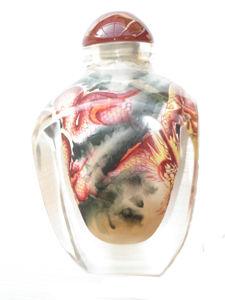

7. Introducing Our New Fine Large White Decorative Chinese Cloisonne Vase - Aug. 2010
Introducing our newest product - a fine large Chinese cloisonne vase with a pair of long-tailed shrikes and plum blossoms. This vase is designed by our own designers.
This beautiful cloisonne vase is based on the shape and theme of vases of the Ming Dynasty. At 12 inches high it will make an attractive addition to any home. It weighs just 2 lbs.
This slender necked vase has a vibrant blue interior and makes for a stunning presentation piece. Manufactured in 2010, it has the qualities of a modern original cloisonne such as thin copper wires, fine grained enamels and smooth surface.
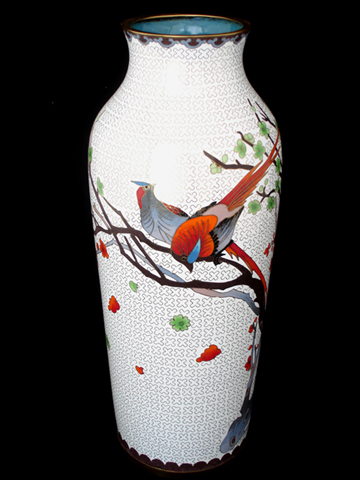
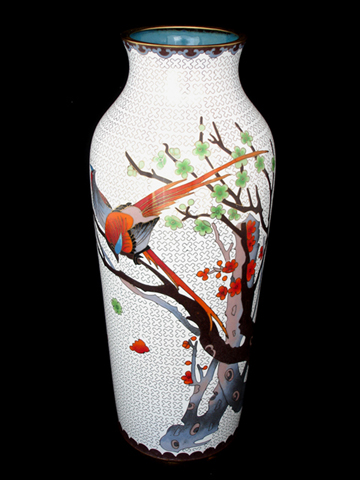
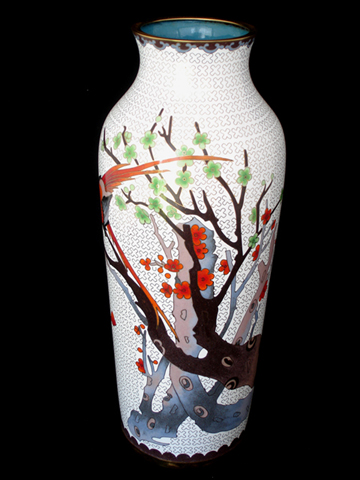
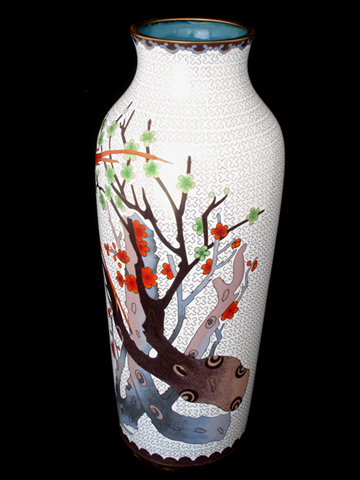
Let's jump to a little history before I tell you a little more about the vase. Did you know that the Ming dynasty ran until 1644 when it was felled by the Shun Dynasty? The Shuns were only around for a matter of months before the Manchu led Qing Dynasty stole the power and they lasted until 1912.
The Ming and Qing Dynasties had their own favored collectibles such as dragons they also had a penchant for using beautiful green jade.
Cloisonne art pieces are gaining in popularity in the home decor world as more people become aware of oriental arts. This particular vase is very popular due to it's charming decoration and light filigree background.
To buy this beautiful cloisonne vase please click fine large white decorative Chinese cloisonne vase We accept Paypal and Credit Cards for payment. Thanks.

6. Ming Dynasty Potteries - Aug. 2010
The earliest Chinese potteries were made in the late Paleolithic period - the dawn of history. There is some indication that there are Chinese potteries as old as 18,000 years, but a more likely figure seems like 10,000 years.
The Chinese created incredibly intricate ceramic art all through the dynastic period. China is rich in the raw materials needed to make pottery - clay, stone to make kilns and glazes, cobalt for the beautiful blue pigments But Chinese pottery as an art form reached it's apex during the Ming and Qing dynasties - the period immediately before the republic of 1911 and after the collapse of the Qing Dynasty.
It was during the Ming period that China became the potter to the world. In fact, the Chinese pottery industry produced two kinds of pottery - that meant for domestic Chinese use and that meant for export. Of these two types, domestic Chinese pottery can be further subdivided into pottery intended for use in the Imperial household and pottery intended for use by ordinary people.
Thus, it is possible to own a Chinese produced Ming pottery at a very reasonable price, if one defines Ming pottery as "porcelain or other ceramic produced in China during the Ming period". You can own a Ming vase intended for export for between ninety and two hundred and fifty dollars.
On the other hand, a piece of Imperial Ming would be impossible to really put a price on in dollars. If you had one, you could name your price if you wished to sell it. Most of the Imperial Ming in existence today is still in China, and what is in Western hands is generally in museums. The likelihood that that "Ming" that you found at a garage sale is an extremely rare or valuable piece is almost nil. Although it is conceivable that Ming intended for domestic use by peasants might end up at a yard sale or thrift store (bear in mind that people have found signed Jackson Pollock originals and Fender XII electric guitars at yard sales - a Ming pottery intended for Chinese peasant use at a yard sale would be about equivalent) pretty much every piece of Imperial Ming still extant has been accounted for and has an extensive and well documented provenance.
Ming pottery was the first pottery that used manganese added to cobalt as an underglaze to make the blue color. In the pottery of previous periods, the blue was rich and brilliant but tended to bleed during firing.
The manganese and the idea of using the blue as an underglaze, rather than on top of the white glaze, allowed painters to paint more and more intricate designs. As is typical of Chinese art, artists took the ordinary and made it extraordinary. For instance, (at the height of the Ming period, chrysanthemums were very popular as pottery decorations. The artists who painted pottery often created detailed, fine, careful representations of the flower.
Imperial Ming always had the mark of the Emperor or Chinese Imperial who commissioned the piece. Domestic pottery sometimes had marks and sometimes didn't. Pottery intended for the export market tended not to.
In the long run, what made the Ming period the greatest period of Chinese pottery was the aesthetic - it was a kind of neo-Traditionalism of its time, much like Westerners would think of modern art a century later. The Ming aesthetic was to use simple colors (blue and white were popular because the cobalt used for the blue and for the underglaze was plentiful), and to render ordinary subjects extraordinary via lovely design.
Ming pottery, for the first time in the history of Chinese ceramic arts, also had a dazzling, blinding whiteness to it. This, combined with the Islamic influence - China by this time had a thriving trade with Turkey and the Ottoman Empire as an endpoint on the Silk Road - meant that the kilns at the Jingdezhen ceramic producing "factory" exported pottery to much of the world.

5. Ren Xiong - One of the Greatest Painter in Qing Dynasty - July 2010
Ren Xiong was born in XiaoShan, Zhejiang Province in 1823. He was a master painter of the Sea school. During a rebellion in 1853, a lot of Chinese intellectuals fled to Shanghai, where a dozen western countries formed concessions after the 1845 Opium War. They found foreign patrons to purchase and collect their works in these concessions.
Ren Xiong created works that were definitely traditional Chinese in style but had folk art elements. The works of Xiong, such as his Self portrait and his Yuyuan garden used bold, exciting, broad brush strokes. His paintings were exuberant, young, full of temper but also a kind of self doubt that was regarded by him as important in a life and in a painting.

Ren Xiong wrote manuals on how to paint - he wrote about how to paint ancient heroes, immortals and hermits (these were popular subjects for Chinese painters at the time.) These manuals proved popular and afforded him some income. He was one of the "Four Rens" - along with his brother, Ren Xun, his son Ren Yu and his nephew and student Ren Yi (who became another very famous painter in late Qing dynasty).
Ren Xiongg showed a talent for painting at an early age and studied with a local portrait master in the hope of making a portrait painter or an illustrator out of him (his mother was a widow; his father died when he was young) but Ren preferred to paint people as they were - he painted village cripples, people who were different in some way from the norm. It could almost be said that Ren showed an early inclination to the style he later adopted - introspective, questioning the nature of things, thinking.

Before this, Chinese painters painted archetypes and ideals. Painting, for instance, a one legged old man who walked with a crutch would have been unheard of. It would have offended the artist to think that such people could possibly be worth painting.
Ren Xiong left home to wander and be an itinerant painter; during this time he lived with a parton named Zhou Xiong. He studied Xiong's collection of paintings, in particular the works of Cheng Hongshu.
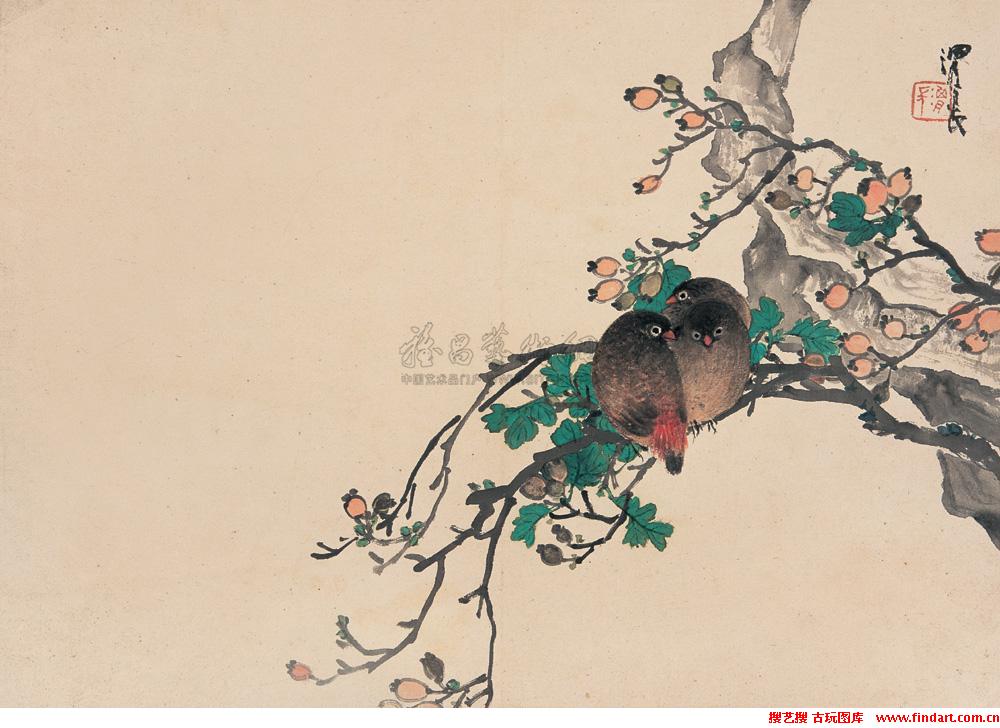
Chen Hongshu's work was the greatest influence on that of Ren Xiong. Hongshu was a late Ming Dynasty painter who, again, unusual for the time, was not interested in painting Chinese ideals and archetypes.
Ren Xiong also made woodblocks and woodblock prints.
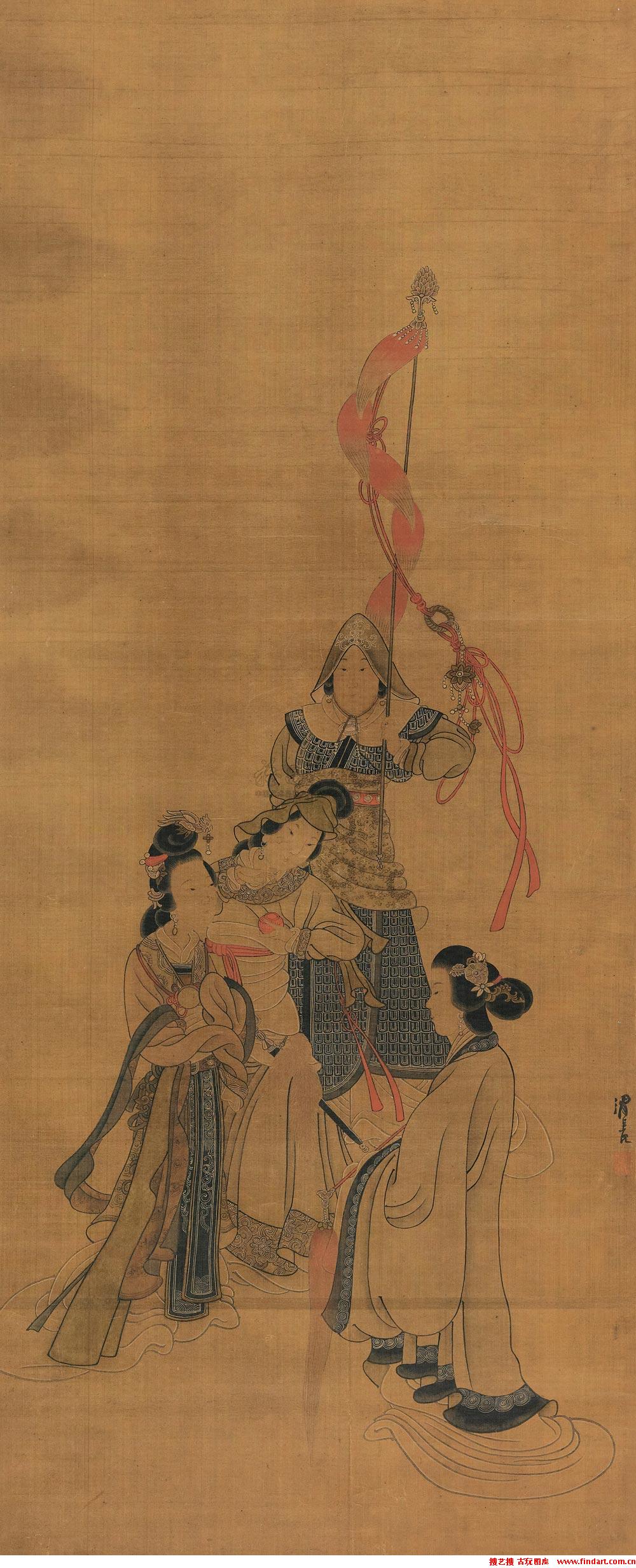
Xiong traveled to Beijing in his late 20s. Beijing was at this time a city mixed with old and new ideologies, local and foreign forces, and conflicts between the rich and poor. It was a great city for an artists; Xiong found many wealthy Western patrons, who came to Beijing for business, politics or opportunity. These patrons brought new ideas of western paintings, such as the use of vivid colors, to Xiong. These ideas had some subtle influences on Xiong's paintings.
It was during this period he painted his most famous painting - his self portrait. The calligraphized inscription on the self portrait is long and expresses frustration and discontent but about what we are left to wonder - about the direction China is heading or about the conflicts between eastern and western forces. Xiong did not say. This portrait is currently preserved by the Palace Museum in Beijing.
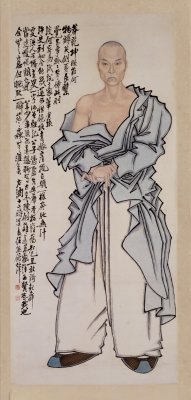
Xiong died in 1858 of tuberculosis. He was one of the greatest Chinese painters, and one of the early developers of the modern Chinese concept of woodblock printing. His painting mixed the Western and the Far Eastern and made the ordinary extraordinary. He is an artist worth studying carefully, and a young artist could do worse than to begin a career by emulating him.

4. Western Vases vs Chinese Vases - July 2010
Vases have been used through the centuries to hold ornaments, flowers and most importantly the ashes of those dearly departed from us - usually covered with a lid. It's understandable to see why people are so interested in them. With their clear brilliance and the fine details in their appearance, vases have become a favorite in many homes. The myth of these Chinese vases being no longer popular is far from the truth. With the differences in western vases becoming more prominent, Chinese vases are coming back into style.
What are the differences between Western Vases and Chinese vases?
Shape:Chinese vases have the shape of an apple core in most of their prominent pieces, with a big round belly, a narrower head and shoulder, and a similarly narrower foot . Western pieces are often more abstract and varied. It can be a tall glass, or it can possess an almost bowl-like quality. The Chinese pieces are much more likely to hold onto their historic heritage.
Detail is in the Design:Not a lot of western vases are very detailed. Even if they do have a design upon them, they are usually big designs that look as though the minimum effort was put into making them. Chinese vases are dedicated to their design with elaborate patterns and designs implemented onto their unique shapes. Flowers, forests, tree and martial arts are careful drawn and painted onto the vases, allowing each one to seem unique.
Color:Western Vases are generally in one solid color, without any intricate patterns or designs embellished upon them. Chinese vases are considered so much more than a vase. They are considered art pieces that are meant to be shared and adorned.
Western vases were deeply influenced by ancient Greek vases. Greek vases varied in functions and shapes but mostly they shared a common big and deep belly. You can easily spot Greek influenced vases everywhere in Europe and in a lot of places in the US, especially in the south.
Ancient Chinese vases had a lot of in common in shapes with Greek vases. Most of these early vases served as functional vessels, such as wine containers. The shapes of vases slowly changed to the dominant apple core shape over centuries and have been holding on to varieties of this shape until recently.
With the growing middle class population in today's China, more people can have the luxury to spend more money on decorative items for their homes. This new wave of wealth has spurred interests in design and manufacturing modern furniture, appliances and home decorations such as vases. Vases have evolved from their homogenous shapes to more varieties. Vases nowadays are made from all sorts of materials such as ceramic, pottery, glass, clay, wood, metal, stone or plastics.
The vases we carry on our website are made mostly from cloisonne and cinnabar lacquer, which are two very traditional trade of arts and crafts of China. Although these vases we carry are in traditional forms, we are working diligently on design and manufacturing more delicate and interesting pieces. Check back to our website in the near future to see these new products.

3. History of Cloisonne - July 2010
Cloisonne is a renowned ancient technique used to decorate metalwork objects. In the early centuries, vitreous enamel was used to engrave colors into these artifacts, however, in the later years they started adding gemstones, precious minerals and glass.
Early Cloisonne Techniques
The History of Cloisonne is a short but interesting one. The technique was developed while working with jewelry in the Near East. There jewelry pieces small; mostly rings and bracelets but due to the popularity of the technique surrounding cultures adopted the process. This is why Cloisonne stands for not only the process of embellishing the product, but also the object itself. The earliest recognition of this art form was found in the Yuan Dynasty that reigned from 1271 and 1368. It was only during the XuanDe period, in 1426, when the product became popular amongst other cultures.
The process in creating a Cloisonne piece was a long and a tiring one. Initially the pot or object had to be base hammered. A coppersmith would create the patterns upon the vase or pieces being created. The object would be painted, only to be filled with enamel. Then the objects would be fired into extreme temperatures to make sure that pigments melted into each appropriate cell. Painstaking dedication was needed, as some objects would need six to seven firings.
The surface was then meticulously polished by a wheel while nowadays an electric wheel is used to polish the enamel. It is then fired for the last time, so that it can finally be polished with a whetstone and carbon. Any metal filigree that was exposed was electroplated with gold or silver. This would prevent any oxidation happening from the dulling of the filigree.
To create the fine shine that is renown through the Cloisonne Artifacts, a final polish was encouraged and then the products were sent off to be sold.
Trade of Cloisonne Artifacts
While trade with the Oriental Countries was booming, Cloisonne trade was not as popular as Porcelain in the earlier centuries. There was a greater focus on the tea, textile and porcelain industry. During the later centuries, the demand and need from Cloisonne increased leading to the lucrative industry we have today.
Unlike Chinese Porcelain, the History of Cloisonne is often not known or remarked upon. With the growing popularity of this art, however, more people are learning about the impact of oriental craftsmanship upon this technique.

2. History on Chinese Porcelain Export - July 2010
Chinese porcelain has long been one of the most treasured and valued porcelain in the world. What started as a small partnership in the 16th Century, developed into one of the most lucrative trading contracts throughout the world. In the 18th and 19th Century, popularity of Chinese porcelain expanded.
As the Chinese Porcelain Export system was monopolized in the beginning years, later centuries offered private business men more opportunities to make money. By then, the wares being sold were of a finer quality than the previous shipments that had gone through. These shipments, purchased by private traders, would be sent via rented space from the Dutch East India Company.
A large part of the shipments that went out from Chinese Porcelain export were tea services and dinner services. A luxury amongst western families, these porcelain services were not affordable to the everyday common man. The distinct patterns found on the Chinese porcelain were generally blue and white, decorated with various pine, flowers and bamboo or pagoda landscapes.
A few savvy tradesmen would first send off their shipments to England or The Netherlands to be enameled (clobbered). By getting them clobbered, they were not only increasing their esthetic appeal but also increasing the price at which to sell them.
Although the quality and standard of the porcelain increased throughout the years, Chinese Porcelain exports started to decline in the 19th century. There were two big reasons for this decline in sales and shipping. The first was, as expected, that people's tastes were changing although this was not the major cause. Industrial Revolution crushed the rest of the sales for Chinese Porcelain. With cheaper, quicker methods of producing dinner and tea services people would often prefer to buy these than spend a lot of money on the Oriental variety.
The most popular style of porcelain being produced in the 19th century was Canton porcelain. Due to the decline in sales and export shipments quality of these products started to decline heavily. By the end of the 19th Century, the Kangxi Porcelain style was being produced in large quantities.
As with everything, Chinese Porcelain export history can give us a precise view of how market demand can shift within a couple years. Luckily, however, Chinese Porcelain export throughout the 18th and 19th Century produced many fine wares that are currently being sold by antique shops and art collectors.

1. Chinese Dragons Symbolize Power, Strength and Energy - June 2010
Chinese Dragons are creatures from Chinese folklore, typically portrayed as long snake-like creatures with four legs. Unlike in Western culture, which typically uses dragons as symbols for evil or war, the Chinese Dragon is a symbol of strength, power, luck, and magical power. It is a benevolent symbol of ethnic identity. The feminine version of the Chinese Dragon is the Chinese Phoenix, the FengHuang. See below a picture of a dragon and a phoenix in one of the cinnabar lacquer plates we carry.
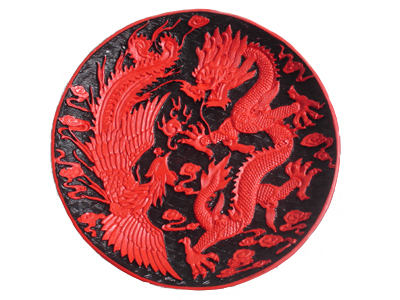
Its use by the Chinese Emperors Yan Di and Huang Di, the first legendary Emperors, contributed to its use in imperial artwork as a symbol of imperial power. During the Qing dynasty, it was featured prominently on robes, pottery, and on the national flag. It is carved into imperial palaces, tombs, and monuments. Here is a picture of the "Nine flying dragons wall" in forbidden city, Beijing, China.
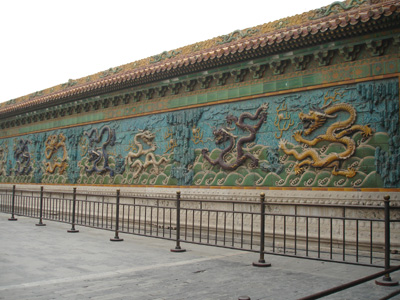
Today, the Chinese Dragon is mostly used for decoration. Even still, its powers are still used by those seeking upward mobility, increased energy, better jobs, or better luck. If you would like to remind yourself of the power of the Chinese Dragon, consider purchasing a vase or jewelry featuring the Dragon. Below is a cloisonne plate featuring a dragon.

In Mandarin, outstanding people are typically compared to Dragons. Chinese proverbs typically feature references to the dragon in this manner.
According to Wang Fu, a Han Dynasty scholar, the mythical Chinese Dragon has nine distinctive resemblances to real creature. He writes, "His horns resemble those of a stag, his head that of a camel, his eyes those of a demon, his neck that of a snake, his belly that of a clam, his scales those of a carp, his claws those of an eagle, his soles those of a tiger, his ears those of a cow." Occasionally, Dragons are depicted with a pearl under their chin. This pearl represents wealth and prosperity.
The Dragon's eternal rival in Chinese culture is the Tiger. In Chinese art, Dragons are typically seen fighting Tigers, locked in an eternal struggle. These symbols are featured prominently in sports and martial arts. On an embroidered silk gauze ritual garment found in a Zhou era tomb in Hubei province, a design features dragons, phoenixes, and tigers.
It may be considered bad luck to depict a dragon facing downward. It is seen as disrespectful to place a dragon oriented in such a manner that he cannot ascend toward the sky.
As ancient symbols of Chinese folklore, the Chinese Dragon is still widely found today in Chinese culture. In Chinese mythology, wearing the symbol of the Dragon may serve to increase your luck, wealth, or power.

